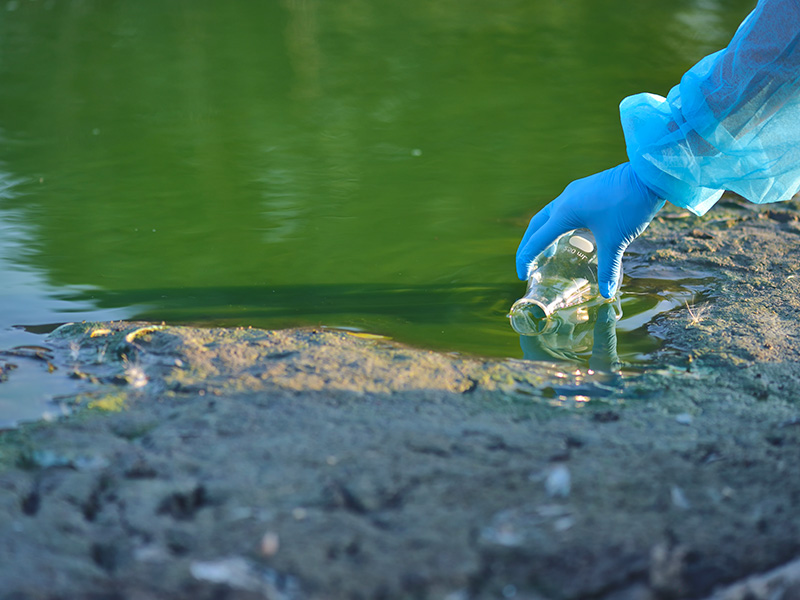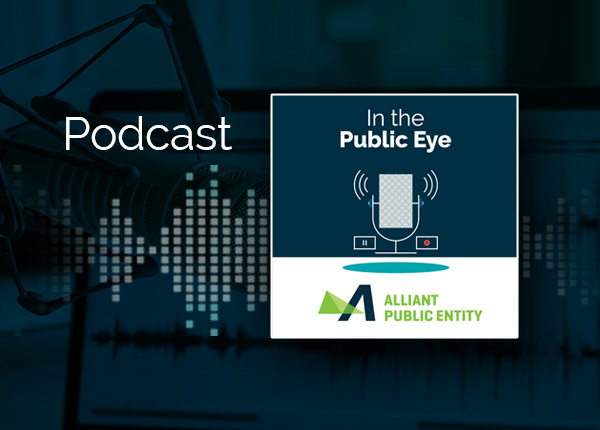Specialty Podcast: What Businesses Need to Know about PFAS Liability Exposure
By Alliant Specialty
PFAS (Per- and polyfluoroalkyl substances) have been around for decades, but advancements in the detection of these forever chemicals has brought about higher standards and increased government regulations. Bill Nellen and David Orleans, Alliant Environmental Group, discuss the potential wave of litigation associated with PFAS and how companies can mitigate the risk of being blindsided by civil actions and held liable for cleanup of PFAS chemicals.
Intro (00:00):
You're listening to the Alliant Specialty Podcast dedicated to insurance and risk management solutions and trends shaping the market today.
Bill Nellen (00:09):
Welcome back to the Alliant Specialty Podcast. I'm Bill Nellen with the Alliant Environmental Group. With me today is David Orleans, who's also part of our environmental team here at Alliant. He has a lot of experience with environmental risks and exposures, putting together complex environmental insurance policies and helping clients through tough claims litigation suits. David, give us your background and then we can start talking about the topic today, which will be PFAS and Forever Chemicals and Emerging Contaminants.
David Orleans (00:46):
Thanks, Bill. My background is in environmental insurance, underwriting, brokerage and law. I've been in this marketplace for about 23 years, focusing on helping clients understand their exposures to environmental risk and then placing negotiated bespoke coverage to make sure that they have the policy they need to help them in the event of some sort of major disaster or even a slow gradual problem that shows up on their property or in their operations. Environmental insurance has been around since the late nineties. I started in 2000, so I feel like I've grown up in this business and have seen different ebbs and flows and market appetites, underwriting interest, and for this topic today, emerging compounds of concern that have generated litigation and overall a lot of attention in the media as to how an exposure to a certain chemical can create a situation where someone is feeling ill or somebody has a cause of action for exposure to it.
Bill Nellen (01:49):
Well, in a way, maybe that helps level set us into this conversation. I mean, anybody can Google PFAS, per and poly-fluoroalkyl substances, and it seems like these are pretty ubiquitous in the environment and in products that consumers use every day.
David Orleans (02:11):
Yes, these chemical compounds, PFAS, they've been in the marketplace, generally speaking, in everything from non-stick cookware to fire retardants and surfactants used by fire departments and lots of places in between for decades, probably since the 1960s. And the manufacturers are the bigger chemical companies, but there are smaller chemical companies that produce them, and then they are in all of these different household products as well as industrial chemicals. So, they really are pervasive in the environment and studies have shown that they have been linked, unfortunately to cancer, thyroid disease, liver damage, and even fertility problems. This wave of information about them started to surface about seven, eight years ago. Then, definitely generated a lot of concern both in litigation in the courts for civil damages, but also in the regulatory agencies in the various states, and now at the federal level with the USEPA.
Bill Nellen (03:11):
What I'm fascinated about with this obviously I'm closer to it than a lot of people in society, but I think the reason that these started to increase awareness about them was because the laboratory analytical techniques got so mature and had rapidly gotten better that they were able to detect these at very small low concentrations and low levels, which then started this wave of concern.
David Orleans (03:44):
Right? These compounds had gone out undetected for many years as states and the federal government require soil testing when you build a new operation of some kind. There are a lot of different ways of testing soil, but it got more fine-tuned around 10 years ago where they could test to the parts per billion of a concentration of a chemical that couldn't have been done before. So, this is a new generation of testing that's part of all sorts of development projects, construction projects, even the disposal of certain soils. So, now we're testing at that degree of specificity, and that's what really first generated all this concern. And like I said, the first wave of litigation was really against the manufacturers who made these compounds. The argument went that these companies knew or should have known that PFAS compounds were this toxic and they were held responsible.
Some of the settlements have been published and they go against some of the larger household brand-name chemical companies that we know of in the marketplace. But it is now sort of trickling down to a second tier, even third tier of responsibility. And the regulations are coming, the states and the federal government are expected to act more uniformly by the end of this year, probably early next year. And as soon as there are regulatory standards, folks will have to clean these things up to a higher degree of specificity themselves under state and maybe even federal orders.
Bill Nellen (05:03):
Yeah. Before we move on to the insurance market, there's been a recent series of articles in the Wall Street Journal has done some investigative reporting around copper wire that was sheathed in lead. And the effects that that is having in the stock market relative to telecom stocks, is crazy. I don't know what the figures are, but double-digit percentage drops based on the potential wave of litigation associated with these cables, which are everywhere. This aging infrastructural telecom thing. We've also seen that this PFAS, as you've alluded to, can have effects on large high-profile companies that made these, and the potential for which would a client of ours, and this is where we get into the insurance, would a client of ours that has PFAS at their property be held liable for cleanup or bodily injury effects? Or would it be the manufacturer who produced these like a product's pollution liability kind of exposure? Or is it both?
David Orleans (06:17):
Well, the answer is it's probably both. When a plaintiff's lawyer sues, they're going to throw everything up against the wall to see what sticks as we say. And they're probably going to first sue more middle market clients, not the manufacturer necessarily, but then when they determine who the manufacturer is, believe me, they're going to add a complaint and an allegation against them in their complaint. The problem is it may be difficult to track who was the actual manufacturer of PFAS compounds that show up at a run-of-the-mill construction site or on a portfolio of land and operations that one of our clients might own.
Bill Nellen (06:52):
And it might presume that they're still in business or financially viable.
David Orleans (06:56):
Exactly. So, the big three, Dow, DuPont and 3M; they've been held responsible, and those are very public. You can find articles about the lawsuits against them very quickly, but there are secondary and even tertiary chemical companies that did manufacture PFAS compounds. But then of course, there are clients that we may have who have never heard of this, never thought they had any re responsibility for it, but suddenly they have a notice of intent to sue from a plaintiff's lawyer who's including them in the lawsuit and the possibility of holding them responsible for some comparative negligence, some share of responsibility for cleaning up the PFAS It may be very difficult for that client of ours to find the manufacturer subrogate effectively. In other words, they will have some defense costs to try to defend this kind of civil action against them.
And environmental insurance, as you know, can cover those defense costs as a first line of defense, so to speak, in a lawsuit against them. The insurance company will frequently want to try to subrogate against the manufacturer if that's possible. But some of those manufacturers may be hard to find and may be hard to prove that they were in fact, the manufacturer. So, our clients may be held liable for a share of the responsibility beyond what they ever thought they might under the concept of simply a failure to maintain safe premises. You own the property, you own the risk, you own the liability. It's very jurisdiction-specific, it different states operate differently. But that trend is here and many of our clients are concerned about it.
Bill Nellen (08:28):
Insurers as a rule, not just environmental insurers and underwriters don't like uncertainty and there's a lot of uncertainty associated with both the litigation but also cleanup standards, health effects, etcetera. So, can you tell us a little bit more about, maybe not, can I get coverage for this, but how insurers are viewing this from an underwriting of new business perspective and what's to come in this area in your opinion?
David Orleans (09:03):
Yeah, it's very interesting. Some of the environmental insurance carriers today, as we're speaking, will automatically exclude PFAS exposures right out of the gate as we start to work with them. And it'll be very hard to talk them down from that underwriting stance. Some carriers will underwrite the exposure, but they will want information about the history of a site. They will want a phase one and beyond that, they will want to know whether our client has any exposure that they can think of to this risk. And they will try to underwrite to that often, with a higher self-insured retention, often with more premium than we might expect. But carriers have been underwriting PFAS for a while now. So, we know that there's some appetite and it's probably going to stay in the marketplace. It's just going to be very conservative in its approach to coverage.
Kind of expensive compared with other risks and probably comes with a high self-insured retention or other coverage limitations. It's very important to understand that dynamic and approach marketing and strategy with a client that way and be very upfront about it. As the litigation continues to grow, as regulations continue to be established and enacted in various states, it is likely the appetite's going to stay narrow and maybe even narrow further. So, getting ahead of the problem and working with the client to explain the exposure, explain some solutions, get information in the way of environmental reports, sampling, testing whatever they may have. Very important to build a strategy around this.
Bill Nellen (10:34):
Do you have to test, do you need to show that you've done testing?
David Orleans (10:39):
This is a classic, “it depends” answer, and Alliant can certainly help with this decision process that you're identifying here. We will always advise our clients to the extent that we can of the legal requirements and the appropriate inquiry into what they have on their property, that could be an environmental concern. So, we will help navigate that process. We will definitely make sure that everything you need to do under the law is there. To the extent we can advise you on that, in most states, except for a couple, I think New Jersey and Michigan right now, you really don't have to test, it's not part of the state regulations unless there's something very specific and unique about your site. And it was very close in proximity to a manufacturing operation that had this. We can help clients understand what's absolutely required and what's more of a discretionary choice.
Bill Nellen (11:31):
So, I have a real-world example actually within the last month where we were working with a private equity firm that was interested in purchasing a company in the cookware business. And they were manufacturing equipment that needed to be refurbished periodically by applying Teflon. And Teflon is either a precursor or a contributor to PFAS or has PFAS as a component with no sampling, and they've been using this treatment process for years, 20 plus years. But we were able to demonstrate that it was used in a very controlled environment and in smaller quantities than one would imagine and stored in very small containers. And so to your point, with some higher deductibles for cleanup of PFAS, the underwriter was able to get comfortable with the risk and we were able to put together a 10-year policy, which enabled our client to successfully acquire and hopefully they can make good on their strategy to increase revenues and drive production with this new PortCo.
David Orleans (12:54):
Yeah, I think there is appetite to get into the details and the technicality and the engineering of how a client handles this exposure. Like many different pollutants of concern that have come before, whether it's mold, legionella, perchlorate, I could go down a list of compounds, it would probably bore most of us. But the underwriters in our marketplace are interested in getting creative, figuring out whether there are good loss control, engineering control institution controls that can give them a pathway to underwriting this exposure.
Bill Nellen (13:26):
Because let's be honest, it's going to drive business.
David Orleans (13:31):
Right.
Bill Nellen (13:32):
Because with increased awareness and increased high-profile lawsuits and defense costs, like you've mentioned, people are going to have to at least investigate it, I think.
David Orleans (13:44):
Yeah, I mean, there's going to be a push to investigate whether it's driven by regulations or it's simply driven by being a good public citizen, or they're worried about the potential exposure to liability down the line from civil suits. Companies are going to look into this risk and they're going to try to figure out a strategic way to test for it, contain it, engineer controls to prevent it from leaking or getting out into the environment. All of these issues are ones that we can help clients better understand and resolve and find a pathway to getting insurance coverage. And I think, like I said before, I mean there will be companies that continue to exclude it, and I think it should be said, although sometimes it goes without saying standard property and casualty carriers will exclude this typically on the absolute pollution exclusion or limited pollution coverage that they might offer. So, it's very important to look to the environmental insurance marketplace as an alternative to the standard property casualty market to actually underwrite this and look at these engineering and loss control measures like Bill just pointed out, and find a way with high retention, sometimes higher premium, some manuscript wording. But there are carriers that I believe, will continue to underwrite this under those parameters.
Bill Nellen (14:54):
Can you give us a short commentary on the value of having a brokerage that has environmental claims advocates? Because I think that's often overlooked or not discussed, and I think that's an important reason why people buy insurance, and you have had a lot of experience with that.
David Orleans (15:15):
Yeah, thanks. I mean, the obvious reason for buying insurance is to have the coverage when you need it, and that means claims. Environmental claims can be sometimes as complex or more than placing the coverage on the front end of the transaction, but in order to make sure that the coverage is actually there when you need it and the claims are paid, there's an advocacy process that I've been involved with throughout my career and I'm involved in it here at Alliant. And that's to make sure that the carriers on the adjusting side, the claims attorneys ask for reasonable information, stay on task and live up to the promises in these negotiated endorsements. Really important to make sure that the carriers are giving the attention that's necessary to keep up with whatever the source of the claim is, whether it's litigation, some regulatory activity carriers have a nice rhythm sometimes with the claim, but others times it can be very difficult to work with certain companies. Our goal is always to place coverage with trading partners that we trust and we have confidence in, but it sometimes boils down to the complexity of the claim, the engineering controls that were used, the engineering controls that may have failed, and we can be there, myself included, to help advocate along that process to prevent the claim from going sideways or from delaying a claim payment and making sure that the client's expectations are met.
Bill Nellen (16:35):
Excellent. Well, thanks for your time today, David. This has been very informative, and we look forward to more in the series of podcasts coming from Alliant and specifically Alliant Environmental Group. Have a great day, everybody.
Alliant note and disclaimer: This document is designed to provide general information and guidance. Please note that prior to implementation your legal counsel should review all details or policy information. Alliant Insurance Services does not provide legal advice or legal opinions. If a legal opinion is needed, please seek the services of your own legal advisor or ask Alliant Insurance Services for a referral. This document is provided on an “as is” basis without any warranty of any kind. Alliant Insurance Services disclaims any liability for any loss or damage from reliance on this document.
Thanks for your message.
We’ll be in touch shortly.




